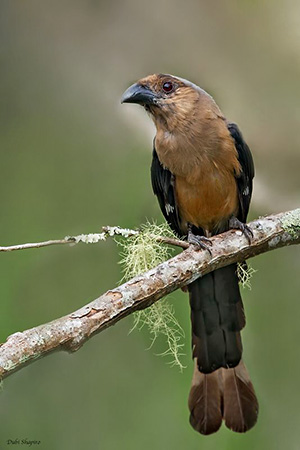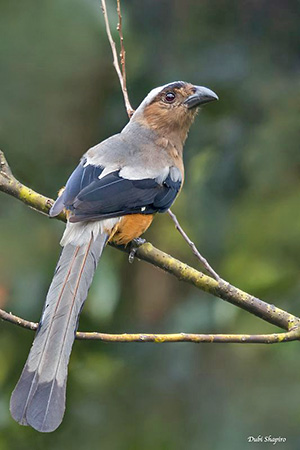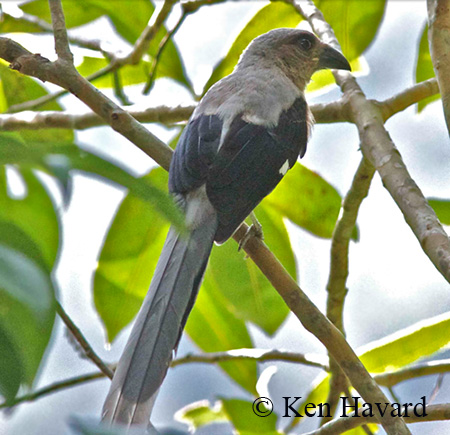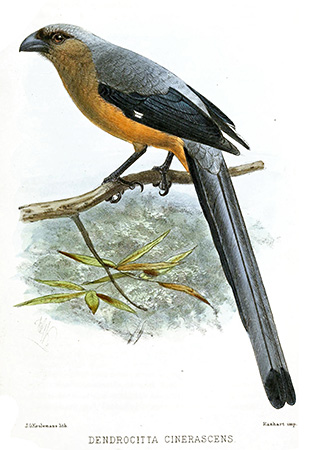
Fr: Témia de Bornéo
Ang: Bornean Treepie
All: Borneobaumelster
Esp: Urraca de Borneo
Ita: Dendrogazza del Borneo
Nd: Borneoboomekster
Sd: borneoträdskata
Photographers:
Ken Havard
My Bird Gallery & Flickr gallery 1 & Flickr gallery 2
Dubi Shapiro
Dubi Shapiro Photo Galleries
Illustration:
John Gerrard Keulemans: 1842-1912
Text by Nicole Bouglouan
Sources:
HANDBOOK OF THE BIRDS OF THE WORLD Vol 14 by Josep del Hoyo-Andrew Elliot-David Christie - Lynx Edicions – ISBN: 9788496553507
Birds of Borneo by G. W. H. Davison – Editeur: Bloomsbury Publishing, 2016 – ISBN: 1472932862, 9781472932860 – 144 pages
CORBEAUX ET GEAIS: Guide des Corbeaux, Geais et Pies du Monde – Steve Madge, Hilary Burn – Editeur : Vigot (18/04/1996) – ISBN 10: 2711412687 – ISBN 13 : 978-2711412686
CROWS AND JAYS by Steve Madge – Ed. Christopher Helm – ISBN: 0713652071
CREAGUS@Monterey Bay (Don Roberson)
Fatbirder - The World’s Richest Information Resource about Birds for Birders
Wikipedia, the free encyclopaedia
Bornean Treepie
Dendrocitta cinerascens
Passeriformes Order – Corvidae Family
INTRODUCTION:
The Bornean Treepie is endemic to Borneo where it is found in montane forests, between 300 and 2,800 metres of elevation. It is usually observed in noisy groups while foraging in tree canopy. It is omnivorous, but the main food items include numerous invertebrates and their larvae.
This species builds a nest with thin twigs and softer materials inside. It is placed in small tree.
The Bornean Treepie is described as common and widespread throughout the range, and it is not globally threatened at the moment.
DESCRIPTION OF THE BIRD:
Biometrics:
Length: 40 cm including the long tail of 21-28 cm.
The Bornean Treepie is a relatively large bird with long, graduated tail and broad, rounded wings.
On the upperparts, mantle and back are pale grey, including on the scapulars bordered with a narrow whitish line on the outer part. Rump and uppertail-coverts are much paler and may appear almost white.
The upperwing is black with a white patch at base of primary flight-feathers. The long, graduated tail has silvery-grey central rectrices, whereas the other feathers are black, like the broad terminal band.
Face and underparts are pinkish-brown to rufous-buff with indistinct greyer shade across the breast. The undertail-coverts are brighter, rather orange-buff. The rectrices are dark brown with broad, darker terminal band.

On the head, forehead, nasal tufts and loral area are rufous-buff, whereas the forecrown shows a variable dark brown bar.
The crown is very pale grey, almost whitish, becoming greyer on the nape, and mixed with purplish-rufous on the hind neck with a light grey wash.
The stout, down-curved bill is grey-black.
The eyes are reddish-brown.
The short, weak legs and feet are grey-black.
Male and female are similar.
The juvenile has body feathers and tertials fringed pale buff, and the central rectrices are narrower than in adults. The bill is pinkish to whitish, not black like in adults.
The 1st year shows worn brown primaries and retained the narrower central rectrices.
RANGE:
The Bornean Treepie is endemic to N and C Borneo. It is commoner in the lower parts of the range, through the mountains of Sarawak, Sabah and Kalimantan.
HABITAT:
The Bornean Treepie is fairly common in mountain range in N and C Borneo. It is usually found from 300 to 2,800 metres of elevation, although being more frequently observed in valleys and foothills.
It frequents forest and forest edge, bamboo thickets, surroundings of villages and cultivated areas.

CALLS AND SONGS: SOUNDS BY XENO-CANTO
The Bornean Treepie’s calls are unmistakable. We can hear fluid whistles, grunts, churrs and emphatic bell-like sounds.
These sounds are varied and include loud and explosive short phrases such as a metallic clang, a raucous squawk followed by a metallic clunk described as “sqwaaak-tonk”. Also a metallic note followed by ringing fading resonance, and a liquid sound followed by two short, harsh notes “plonk,grah,grah”.
The Bornean Treepie is a noisy bird, often seen in pairs or in groups, calling both in flight and while perched.
This species is also able to mimic calls of other bird species and various forest sounds.
BEHAVIOUR IN THE WILD:
The Bornean Treepie is omnivorous, although its diet primarily includes a large variety of invertebrates and their larvae such as cockroaches, grasshoppers, beetles and moths. But it also consumes seeds and berries.
It forages singly or in small parties throughout the tree canopy, but also at all levels.
When coming to the ground, it seems rather clumsy because of the short legs, while the long tail is raised.
The groups can be seen around villages where they scavenge for food scraps. They also visit cultivated fields where they feed on rice and fallen grain.

We can see here the pale whitish gape (black in adults) and the overall duller coloration.
Probably a young bird.
The behaviour of the Bornean Treepie during the breeding season is unknown. The species is believed to be a solitary breeder.
The courtship displays are not described, but we can suggest that the long, graduated tail is enhanced by adapted movements and postures.
The cup-shaped nest is built in the canopy of small tree or tall shrub.
The Bornean Treepie is sedentary and resident in the mountains of northern and central Borneo.
Like most arboreal species, the Bornean Treepie has relatively short, rounded wings, involving laboured flight with frequent wingbeats. In addition, the long, graduated tail makes the flight more difficult, but this ornament is conspicuous in the air.
REPRODUCTION OF THIS SPECIES:
The breeding season of the Bornean Treepie takes place at the beginning of the year, with eggs found from early January to mid-March.
The nest is described as a shallow cup made of fine twigs, and lined with rootlets and soft plant material. It is placed within the canopy of small tree or tall shrub, in scrub jungle.
From some observations, two nests contained two eggs (but this species probably lays more eggs). The eggs were greenish-white with brown markings forming a ring at the larger end.
No more information.
PROTECTION / THREATS / STATUS:
The Bornean Treepie is described as common on Borneo. It is widespread in N and C Borneo.
It usually favours secondary forests, good news for the survival of the species.
The size of the population is unknown, but the species is not considered globally threatened.
The Bornean Treepie is currently evaluated as Least Concern.
